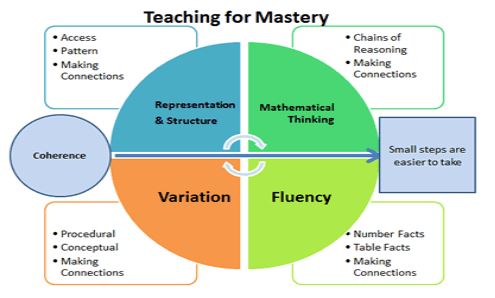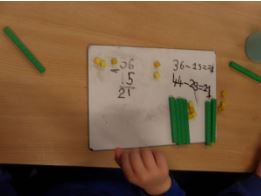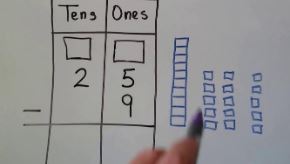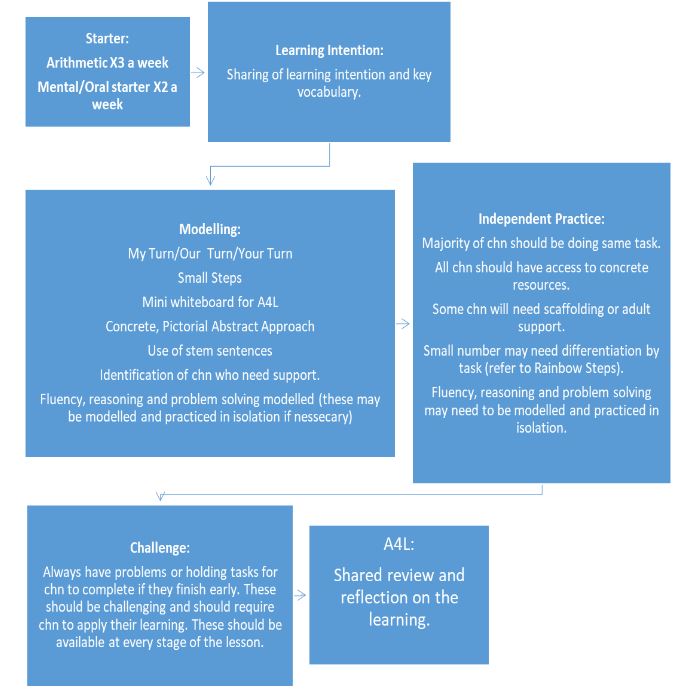Mathematics
Please click HERE to see an overview of what Maths is taught in each of the year groups.
Subject Intent
At Whitehill Primary school, children learn to recognise and make sense of the maths in the world around them. Using the Concrete, Pictorial and Abstract approach, teachers allow children to develop a mastery of the maths curriculum. With skilled teaching in small steps, concrete and pictorial resources are used to bridge gaps in understanding so that all children develop a deep understanding of the number system and calculations. They grow to appreciate relationships and pattern in maths and develop knowledge that is both automatic and flexible. Children must develop automaticity in the recall of key facts and procedures so as to reduce cognitive load. We structure our teaching and progression in order to ensure that our children develop these necessary arithmetic skills. Our mastery approach builds upon this foundation and encourages greater depth in understanding that allows this knowledge to be applied to a range of contexts. Reasoning and problem solving are embedded within the curriculum. The ability to articulate and justify their method using precise vocabulary and what might happen if a particular variable is changed are the hallmarks of a mathematician.
Aims & Expectations
At Whitehill Primary School, the aim of our Maths curriculum is to ensure that all children are able to master mathematics appropriate to their year group and that they leave our school “secondary ready”. We use the White Rose Maths schemes of learning, and a modified version of their resources in order to provide a comprehensive and expertly designed journey though the world of Mathematics. White Rose is based on a teaching for mastery model which is a small steps approach that keeps all learners together. It is underpinned by the Concrete, Pictorial and Abstract method. By using the resources across the school we can ensure consistency of the mathematical elements and comprehensive coverage of the curriculum. We believe that this approach will facilitate consistent delivery of Mathematics across the school and across the inevitable ability range within year groups. It is also designed to support mathematicians who require more time and visual representation to grasp fundamental concepts and those who require challenging further to achieve Greater Depth.
What is Teaching for Mastery?

Based on “FIVE BIG IDEAS IN TEACHING FOR MASTERY” by NCETM
https://www.ncetm.org.uk/teaching-for-mastery/mastery-explained/five-big-ideas-in-teaching-for-m
Fluency
Quick and efficient recall of facts and procedures and the flexibility to move between different contexts and representations of mathematics. Developing automaticity in these aspects allows for cognitive load to be devoted to higher order thinking.
Representation and Structure
Mathematical structures are the key patterns and generalisations that underpin sets of numbers – they are the laws and relationships that we want children to spot. Using different representations can help children to ‘see’ these laws and relationships. Representations used in lessons expose the mathematical structure being taught, the aim being that students can do the maths without recourse to the representation.
Variation
Variation is twofold. It is firstly about how the teacher represents the concept being taught, often in more than one way, to draw attention to critical aspects, and to develop deep and holistic understanding. It is also about the sequencing of the episodes, activities and exercises used within a lesson and follow up practice, paying attention to what is kept the same and what changes, to connect the mathematics and draw attention to mathematical relationships and structure.
Mathematical Thinking
If taught ideas are to be understood deeply, they must not merely be passively received but must be worked on by the student: thought about, reasoned with and discussed with others. Pupils must be encouraged to look for patterns, relationships and make connections.
Coherence
Lessons are broken down into small connected steps that gradually unfold the concept, providing access for all children and leading to a generalisation of the concept and the ability to apply the concept to a range of contexts.
Concrete Pictorial Abstract
Concrete, Pictorial, Abstract (CPA) is a highly effective approach to teaching that develops a deep and sustainable understanding of maths in pupils. This is the vehicle that teachers in Whitehill use in lessons to represent structures being taught and expose them. It is not a “one size fits all” process and each step will not always be appropriate to the topic. The ultimate aim of this process will always be that children in Whitehill internalise the representations and can access the maths on an abstract level.
Concrete
Children are encouraged to solve problems each day through the use of concrete resources, pictorial representations and abstract thinking. (Outlined below) Concrete is the ‘doing’ stage, using concrete objects to solve problems. It brings concepts to life as children have the opportunity to be hands on and use physical objects to aid them in developing their understanding
stage, using concrete objects to solve problems. It brings concepts to life as children have the opportunity to be hands on and use physical objects to aid them in developing their understanding
Pictorial
Pictorial is the ‘seeing’ stage, where representations of the objects are used to support learning. This stage encourages children to make a mental connection between the physical object and abstract levels of understanding, by drawing or looking at pictures, circles, diagrams or models which represent the objects in the problem.
object and abstract levels of understanding, by drawing or looking at pictures, circles, diagrams or models which represent the objects in the problem.
Abstract
Abstract is the ‘symbolic’ stage, where children are able to use abstract symbols to model and solve Maths problems. 
A Visual Summary of the CPA Approach

EYFS
All maths learning in EYFS is based on the document “Development Matters”. In Nursey, a mixture of formal teaching and informal learning opportunities that follow the interest of the children are used. In Year R, teachers follow the White Rose schemes of learning – principally securing the representations of numbers up to 10 and recognising number to 20. Children are encouraged to spot patterns and identify differences through variation. EYFS children begin their fluency journey by noticing and recalling numbers up to 20. EYFS practise is predicated on exploration and discovery with songs and repetition to secure foundational knowledge.
Key Stage 1
The principal focus of mathematics teaching in key stage 1 is to ensure pupils develop confidence and mental fluency. The essential idea behind the mastery approach is that all children have a deep understanding so that future learning continues to build on solid foundations. If the subject is represented using concrete materials, pictorial representations and abstract symbols, it will allow children to visualise maths in varied ways, see connections and to independently explore and investigate a topic. Practical activities and resources offer the children a deeper mathematical understanding of more complex concepts. Providing children with visual representations also offers a scaffold when developing a more robust understanding of maths. Throughout Key Stage 1, it is important that children gain a secure knowledge of number and place value and become confident when using the four operations in both formal methods as well as problem solving where often the approach is not immediately evident. Alongside number work, pupils begin to identify fractions using shapes, objects and quantities and make connections to equal sharing and grouping. Pupils are taught to count to ten in fractions, recognise equivalent fractions and develop their understanding of fractions on a number line. At this stage, pupils will also develop their ability to recognise, describe, draw, compare and sort different shapes. Pupils have the opportunity to use a range of measures to describe and compare different quantities such as length, mass, capacity/volume, time and money and are expected to use related vocabulary for all topics. Other subjects may have strong links to some maths topics allowing cross-curricular teaching. For example, shape through art or computing, measures through science or coordinates in geography. This is to ensure we continually maximise learning opportunities for all pupils across an entire curriculum.
Key Stage 2
Lower Key Stage 2 – Years 3-4: The principal focus of mathematics teaching in lower Key Stage 2 is to ensure that pupils become increasingly fluent with whole numbers and the four operations, including number facts and the concept of place value. This should ensure that pupils develop efficient written and mental methods and perform calculations accurately with increasingly large whole numbers. At this stage, pupils should develop their ability to solve a range of problems, including with simple fractions and decimal place value. Teaching should also ensure that pupils draw with increasing accuracy and develop mathematical reasoning so they can analyse shapes and their properties, and confidently describe the relationships between them. It should ensure that they can use measuring instruments with accuracy and make connections between measure and number. By the end of Year 4, pupils should have memorised their multiplication tables up to and including the 12 multiplication table and show precision and fluency in their work.
Upper Key Stage 2 – Years 5-6: The principal focus of mathematics teaching in upper Key Stage 2 is to ensure that pupils extend their understanding of the number system and place value to include larger integers. This should develop the connections that pupils make between multiplication and division with fractions, decimals, percentages and ratio. At this stage, pupils should develop their ability to solve a wider range of problems, including increasingly complex properties of numbers and arithmetic, and problems demanding efficient written and mental methods of calculation. With this foundation in arithmetic, pupils are introduced to the language of algebra as a means for solving a variety of problems. Teaching in geometry and measures should consolidate and extend knowledge developed in number. Teaching should also ensure that pupils classify shapes with increasingly complex geometric properties and that they learn the vocabulary they need to describe them. By the end of Year 6, pupils should be fluent in written methods for all four operations, including long multiplication and division, and in working with fractions, decimals and percentages.
Active Ingredients of Mathematics in Whitehill Primary School
- Planning should start with the White Rose Scheme of Learning, the White Rose Calculation Policies and the Rainbow Steps all of which can be found on the shared area.
- Planning should take a Concrete, Pictorial and Abstract approach with all children having access to concrete resources (where appropriate) and the aim being to move them towards the abstract.
- White Rose Premium Resources should be used if appropriate, however, this is where a teacher’s professional judgement come into play. Fidelity to the scheme is key not to the resources.
- Concrete and pictorial representations should be consistent with modelling.
- Explicit teaching of key vocabulary with use of Stem sentences. Insistence on use of full sentences by both children and adults.
- Clear modelling by teacher with use of My Turn, Our Turn, Your Turn.
- Use of mini whiteboards for A4L and teachers making judgements based on what they see.
- Scaffolding and support- Where possible all children should be doing the same activities with all children having access to fluency, reasoning and problem solving. These activities will typically have a low threshold but high ceiling in their learning.
- Teacher should use professional judgement to decide when children are ready for recording work in books. If their class needs a full day of concrete or pictorial learning in order to provide a firm foundation, then this is what should happen.
- Concrete and pictorial resources should provide the scaffold and the bridge in learning. If a child is two years or more behind, then, differentiation by task may be needed. If a child is not at ARE but can access the lesson, they may need a “streamlined” version of an activity which still retains the core elements.
- When children have mastered a concept, they should be provided with activities that bring depth to their learning. Children should know that if a task is completed there will always be a challenge to complete.
- Activities should be displayed on the board and children should write directly into books where appropriate with an emphasis on minimal printing. Children should be encouraged to show their work and include jottings demonstrate their understanding. Children with SEN may need a scaffolded version to themselves in order to support their learning.
- Children should be supported by the environment in their classroom. The working wall should act as an “aide memoir” to support children. It should demonstrate the journey of the learning with clear modelling, mathematical vocabulary and stem sentences.
Presentation of Work and Marking:
- LI should be in PPT but does not need to be in book.
- Short date should go at top of page.
- Margin should be drawn for KS2 with a width of two squares in the middle.
- There should be high expectations of presentation with chn writing one digit in one square.
- The majority of feedback should be verbal and immediate when given to a focus group and the rest should be acknowledged with ticks for correct answers and circles around incorrect answers.
Maths Lesson Structure

Inclusion & Equal Opportunities
Teaching maths for mastery is different because it offers all pupils access to the full maths curriculum. This inclusive approach, and its emphasis on promoting multiple methods of solving a problem, builds self-confidence and resilience in pupils. Though the whole class goes through the same content at the same pace, there is still plenty of opportunity for differentiation. Taking a mastery approach, differentiation occurs in the support and intervention provided to different pupils, not in the topics taught, particularly at earlier stages. Where possible there is no differentiation in content taught, but the questioning and scaffolding individual pupils receive in class as they work through problems will differ, with higher attaining children, or those pupils who grasp concepts quickly, challenged through more demanding problems which deepen their knowledge of the same content. Those children who are not sufficiently fluent are provided additional support to consolidate their understanding before moving on. Pupils’ difficulties and misconceptions are identified through immediate formative assessment and addressed with intervention – commonly through individual or small group support later the same day where possible. Where children make less than expected progress efforts are made to ensure relevant support is put in place to help support the child. Concepts will be revisited throughout the year during challenge times or intervention times to help with long term understanding. Where children are operating at a pre-key stage level, then they should have a personalised curriculum in place and tasks should be differentiated accordingly.
Parental Involvement & Wider Community Links
Parental involvement is an essential aspect to Maths, especially for the development of fluency in the recall of number facts. It is crucial that the school and parents work together in order to support the pupils at Whitehill. In order to achieve this, there is an expectation that the school will set pupils number facts practice at home. There is also the expectation that parents will practice these with their children at home and that the school will provide information to support parents in doing this. Furthermore, we would like to regularly invite parents into school to for maths events that develop cultural capital. This will allow parents to come into school and to share positive enriching experiences with their children that centre around maths. We will also run workshops with parents to show ways of supporting and developing maths at home.
Monitoring
In maths, we will use target tracker as a way of monitoring assessment. Teachers will upload data to the Target tracker system 3 times per year. This will allow us to monitor and assess areas of strength and weakness. To further support this assessment, we will have in house moderation meetings where we can discuss needs and challenge each other regarding our assessments. To help teachers assess in maths we will continue to use standardised assessments 3 times per year. We will also use Times Table Rockstars Soundchecks to assess pupils on their times tables. Teachers can then amalgamate their knowledge of the pupil and assessment results to finalise their decisions.
Monitoring will also be carried out by the leadership team and the Maths Lead through the means of book looks, lesson observations and learning walks with a focus on learning and progress. Through consultation together they will be able to assess the effectiveness of the curriculum and plan suggestions and next steps for moving forwards.
Supporting Documents:
Mathematics programmes of study: Key stages 1 and 2 National curriculum in England
EYFS Development Matters:
White Rose Calculation Policies:
Addition and Subtraction: ..\..\Downloads\Addition and subtraction calculation policy (1).pdf
Multiplication and division: ..\..\Downloads\Multiplication and Division calculation policy V2.pdf


